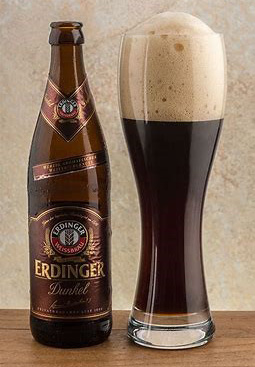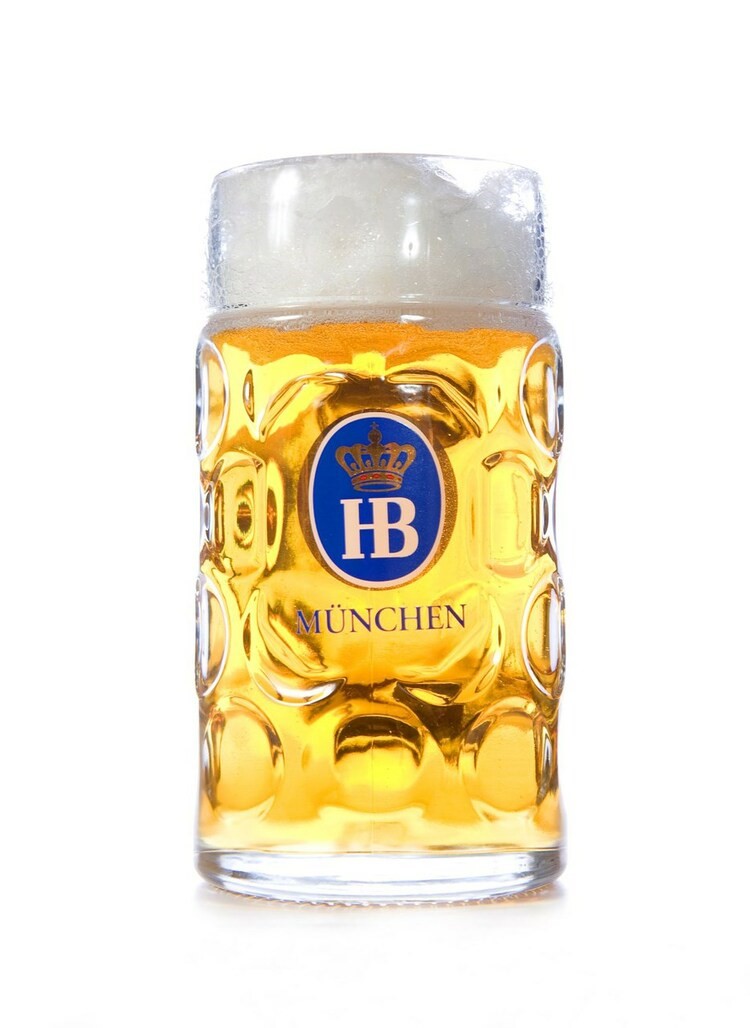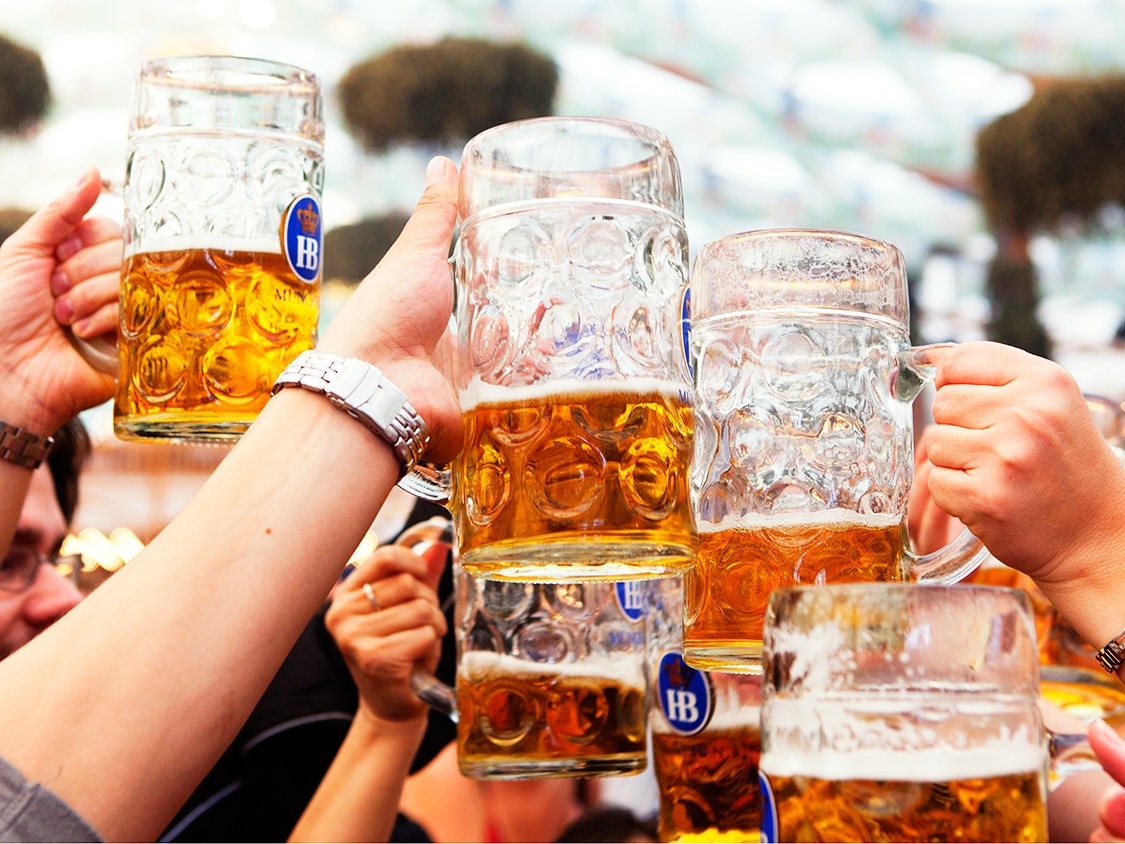By Jack Horzempa

It all started with a wedding and a HUGE party. In October 12, 1810 the Crown Prince Ludwig (who would later become King Ludwig I) got married to Princess Therese in Munich. This royal wedding included a celebration to which all of the citizens of Munich were invited to attend. The celebration occurred on the fields outside of the city gates which from that point on were called Theresienwiese, meaning "Theresa's fields". A shortened version of this name for the fields would become “Wies’n”. The party went on for five days and at the completion of the celebration there was an exciting horse race to close out the event.
This wedding celebration was such a hit that a repeat event occurred the following year and in addition to horse racing an agricultural fair was added to promote the Bavarian economy and agriculture.
In subsequent years this now annual event would continue to grow and add festivities; the first ride and two swings being in place for 1818. In 1819 the duration of the event was lengthened and the start date was moved up to the end of September to take advantage of warmer weather and longer days.
One aspect which remained consistent from the beginning of the annual Oktoberfest celebration was the abundance of beer available for the celebrating Bavarian people. The beers of the early 1800’s would have been quite dark (dunkel in German) in color since the malt used to produce those beers were darkly kilned. Those Dunkel beers were lagers.

Why is Oktoberfest beer associated with a month? When it came to brewing beer in Germany the seasons were quite important. In the mid-16th century, the Duke of Bavaria Albrecht V decreed that beer could not be brewed during the hot times of the year since brewing when warm/hot often resulted in beers of poor quality. Under Albrecht’s decree, brewing was only permitted from St. Michael’s Day (September 29th) to the feast of St. George (April 23rd). The beers consumed during the summer and early fall therefore had to be produced in the winter/late spring months and the beers consumed at the Oktoberfest celebration were the beers brewed in March and then stored in caves filled with ice (i.e., lagered for the summer months). The beer consumed at Oktoberfest could then be referred to as being a March (Märzen) beer.
Märzen is also a strength designation of German beer so there is some potential conflation of terminology here. In Bavaria, by law any beer called Märzen has to have an original gravity of at least 13.5° Plato. Elsewhere in Germany it's 13° Plato.
For the first six decades of Oktoberfest celebrations the beers served would be Dunkels but during that time two industrious European brewers were conducting some research. In the early 1830’s Anton Dreher (Austrian) and Gabriel Sedlmayer II (Bavarian) visited Great Britain to learn about their brewing techniques. Part of that education involved ‘borrowing’ some wort and yeast samples but more importantly for the continuing development of beers to serve for the Oktoberfest celebration they learned about British malting. The British employed gentler drying (kilning) techniques that resulted in a lighter colored malt. The British called this lighter color malt Pale Malt. While the word “pale” is used the resulting beers were actually amber in color but most certainly paler in color compared to other British brewed beers (e.g., Porter).
Anton Dreher was quicker to incorporate what he learned about British malting techniques to brew an amber colored lager at his Schwechat Brewery in Vienna in 1841. Dreher called his paler colored malt Vienna Malt. He used a grain bill of 100% Vienna Malt to produce his beer which he dubbed a Vienna lager, staying consistent to the “Vienna” theme.
The production of an amber colored lager in Bavaria took a bit more time. Perhaps the Bavarian beer consumers were quite happy with their Dunkels so why change? But change did eventually come to Bavaria. Gabriel Sedlmayer II along with his brother Josef took ownership of Spaten Brewery after their father died in 1839. It wasn’t until 1871 that Josef brewed in Munich a small batch version of a Vienna Lager (at Franziskaner brewery, which later merged with Spaten). This new beer was described as being amber-red in color and in comparison to a Munich Dunkel was more pale in color. In March 1872, Josef made a full-up production batch of this beer, lagering it until September when it was released for consumption by thirsty celebrators at Oktoberfest. This beer was branded as Märzenbier and it was available for consumption by the thirsty celebrators at the 1872 Oktoberfest. There is an interesting story that at the 1872 Oktoberfest they were running low on the traditional Dunkel beer but Josef Sedlmayer had brewed sufficient quantities of Märzenbier to be able to serve those thirsty Bavarian and make them happy. I do not know whether there is any truth to this story but 1872 was the year in which the beer served at Oktoberfest transitioned from Dunkel to an amber colored lager.
The brewers took a cue from Anton Dreher and branded the malt used to brew this beer as Munich Malt.

To this day Spaten labels their Amber Oktoberfest beer using the term “Ur Märzen” which roughly translates to Original Märzen. This is exaggerated marketing since as has been discussed the first beers of Oktoberfest were Dunkels.
For over a hundred years the beers served at Oktoberfest were amber colored. It became common to call these beers Oktoberfest beers or alternatively Märzens. The most popular selling Oktoberfest beer in the US is one from Sam Adams and for marketing purposes use a “c” vs. a “k”: Octoberfest. This beer was first brewed in 1989 and as per ‘tradition’ it was indeed amber in color.

But over the past few decades the beers served at the Oktoberfest celebration have become lighter and lighter in color. When it comes to beer the Germans prefer to use the word helles (which literally translates to brilliant) to detail a light-colored lager. The most popular beer style in Bavaria is the Helles and there is a connection to Spaten here as well – Spaten Brewery was the first to produce a Helles beer in 1894.
Why have the beers served at Oktoberfest over the past few decades transitioned from an Amber Oktoberfest beer to a Pale Oktoberfest beer? Well, one theory: it’s all about the money. Oktoberfest is a large source of revenue for the City of Munich and only the six Munich breweries are permitted to operate large tents there and serve beer: Augustiner, Hacker-Pschorr, Löwenbräu, Paulaner, Spaten and Hofbräu-München. The story goes that Paulaner sometime in the 1970’s decided to serve a beer more golden in color. Did Paulaner sell more of their golden colored beer (Pale Oktoberfest) than their competitor’s amber colored beers (Amber Oktoberfest)? I do not have sales data but I would be willing to bet the answer is yes since one by one all of the other Munich breweries decided to provide Pale Oktoberfest beers to thirsty beer customers over the ensuing decades. Nowadays there is no Amber Oktoberfest beers to be found on the Theresienwiese grounds. Perhaps a simple case that these Pale Oktoberfest beers provided increased drinkability and therefore sales of beer increased accordingly.

For emphasis the beers served at Oktoberfest are not the ‘regular’ Helles beers from the six Munich breweries. They will differ in having an increased amount of malt (e.g., higher original gravity/higher ABV) and likely an increased amount of non-Pilsner malt in the grain bill.
Dunkels are still being brewed in Germany but when it comes to the overall Oktoberfest beer style there are now two types:
There is obviously a difference in the grain bill between the two types as evidenced by the difference in color. I am an advocate that these beer styles are best brewed solely using base malts but judicious utilization of specialty (e.g., crystal/caramel) malts can indeed produce tasty Oktoberfest beers as well.
For the Amber Oktoberfest some darker base malts (e.g., Munich Malt) needs to be part of the grain bill and typically Pilsner Malt is used as well. A simple grain bill of 50/50 Munch Malt and Pilsner Malt would produce a fine Amber Oktoberfest beer. Another base malt which could be used is Vienna Malt and as you read later for my recipe I suggest a mix of Pilsner, Munich and Vienna. If some crystal/caramel malt is used I strongly suggest that it be less than 10% of the grain bill with something like 5% being a prudent choice. An example of a specialty malt which could be used is CaraMunich. For extract brewers there are Liquid Malt Extracts branded as Munich Malt extract which are made from a 50/50 mix of Pilsner which are well suited to brew an Amber Oktoberfest.
The grain bill of a Pale Oktoberfest will be predominantly Pilsner Malt (e.g., 80+ percent) and some Munich or Vienna Malt (e.g., 20 percent or less). Some specialty malt like CaraPils could also be used but brewing solely with base malt is best here in my opinion.
Regardless of the type of Oktoberfest beer the hops to be used would be German noble hops: Hallertau Mittelfruh, Tettnang, and Spalt. Other hops could also be considered like Hersbrucker, German Tradition, or Czech Saaz. Since both Oktoberfest types are malt forward beers the hops should play a secondary role in the flavor profile. A simple hopping schedule of just a bittering addition and a small addition for the last 15 minutes of boil for flavor serves these beers well. The bitterness level should be low/medium (e.g., 20 – 28 IBUs).
A German lager yeast strain is a good choice for this beer style. The two lager yeasts I have used the most for this beer style is from Wyeast: 3633 and 2206.
Wyeast 3633 is my personal preference and it happens to be a blend. From the Wyeast website:
“STRAIN: 2633 Octoberfest Lager Blend™
Species: Saccharomyces pastorianus blend
Profile: This blend of lager strains is designed to produce a rich, malty, complex and full bodied Octoberfest style beer. It attenuates well while leaving plenty of malt character and mouthfeel. This blend is low in sulfur production.
Metric Temperature Range: 9-14 °C
Flocculation: Low - Medium
Attenuation: 73 - 77
Temperature Range: 45 - 58°F
Temperature Range
ABV: 9”
https://wyeastlab.com/yeast-strain/octoberfest-lager-blend
For homebrewers who do not have the ability to conduct a cool temperature fermentation there are other choices which can be made. There are two lager yeast strains which will produce clean beers (e.g., low levels of esters) even if fermented warm (e.g., 68 °F): Wyeast 2124 and Fermentis W-34/70.
Another option is to use a clean ale yeast and create an Oktoberfest Ale. Fermentis US-05 would be one example here.
In the March/April 2014 issue of Zymurgy Martin Brungard discussed the brewing water in Bavaria. He provided the following recommended Bavarian brewing water:
German brewers tend to prefer to conduct a step mash but with today’s well modified malts a single temperature infusion mash is sufficient to conduct a mash. I prefer to hit a mash temperature in the middle part of the range (e.g., 153 °F). Selecting a lower temperature (e.g., 149 °F) would result in a more fermentable wort which may be desirable for a Pale Oktoberfest if you are seeking to maximize drinkability. Selecting a higher temperature (e.g., 156 °F) would result in a less fermentable wort which may accentuate the maltiness of an Amber Oktoberfest.
Pilsner Malts are higher in S-Methylmethionine (SMM) than other base malts (e.g., Pale Malt). SMM is a pre-curser to Dimethyl Sulfide (DMS) which can cause flavors described as creamed corn or cooked vegetables in the resulting beer. Conducting a vigorous and longer duration boil will drive off SMM and consequently diminish the amounts of DMS in the wort/beer. Some people like to boil their wort from a mash which includes Pilsner Malt for 90 minutes to maximize driving off SMM. I personally choose to boil my wort which includes Pilsner Malt for 75 minutes and that duration works for me. I have read on homebrewing forums that some folks only boil for 60 minutes and they do not perceive DMS in their beers. There are various factors here:
Select the boil duration that best suits your preferences here. Just be aware that Pilsner Malt is indeed high in SMM compared to other base malts.
Lager beers such as an Oktoberfest are classically fermented cool. While Wyeast 3633 has a fairly warm upper range (i.e., 58 °F) out of habit I prefer to ferment cooler (e.g., 50 – 53 °F). My standard practice is to conduct a two week fermentation which fits nicely with weekend brewing and subsequent transfer but let the yeast decide when the beer is done primary fermentation (i.e., reached final gravity and no perceptible fermentation by-products such as acetaldehyde or diacetyl).
Towards the end of fermentation you could choose to elevate the temperature a bit (e.g., 68 °F) to ensure that all of the diacetyl produced during the primary fermentation is processed; this step is referred to as a diacetyl rest.
Click here to learn More! about Diacetyl Rest
As was previously discussed there are some lager strains that will produce clean beers even when fermented warm. I have no experience here but I have attended presentations (e.g., HomebrewCon) and read many posts/videos which discuss this for Fermentis W-34/70 and Wyeast 2124. If I did not have the capacity to ferment cool I would be comfortable to ferment with these yeast strains warm to produce an Oktoberfest.
And if you prefer, you could use a clean ale yeast such as US-05 to produce an Oktoberfest Ale.
Classically an Oktoberfest is lagered at cold temperatures after primary fermentation is complete. I transfer from my primary to a secondary for lagering. I have found that about five weeks of cold conditioning is sufficient for completion of lagering. I personally bottle my beers after lagering is complete.
For folks who keg their beer just transfer to the keg after primary fermentation is complete and then force carbonate & cold condition for about five weeks. You can sample your beer along the way and decide for yourself when the beer is done.
Batch Size: 5.5 gallons
Target OG: 1.055
Target FG: 1.012
Color: 7 - 10 SRM
Target Bitterness: 26 IBUs
Ingredients:
Additional items:
Directions:
Mash at a water-to-grist ratio of 1.5 qts/lb. Adjust brewing water to be consistent with Bavarian water profile and add lactic acid to achieve a mash pH of 5.2 – 5.4. Mash at 153 °F for 60 minutes. Sparge until approximately 7 gallons of wort is achieved (tailor amount based upon your boil off rate to obtain 5.5 gallons of wort post boil).
Boil vigorously for 75 minutes in an uncovered brew kettle adding the Tettnang hops at the beginning of boil. Add 0.5 ounces of Hallertau MIttelfruh hops for the last 15 minutes for a flavor addition.
Ferment cool (or warm if using W-34/70 or Wyeast 2124) until final gravity is achieved; conduct a diacetyl rest towards the end of fermentation if you prefer. Transfer to a lagering vessel (e.g., carboy, keg) and lager cold (e.g., 35 °F) for about five weeks. Package when lagering is complete.
Jack’s Pale Oktoberfest
Change the malt bill to 9 lbs. of German Pilsner Malt and 1.5 lbs. of Vienna/Munich Malt in the above recipe and keep everything else the same.
And raise your mug of Oktoberfest beer high and say out loud “Prost!” with gusto.

All contents copyright 2024 by MoreFlavor Inc. All rights reserved. No part of this document or the related files may be reproduced or transmitted in any form, by any means (electronic, photocopying, recording, or otherwise) without the prior written permission of the publisher.